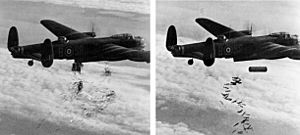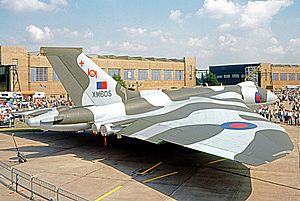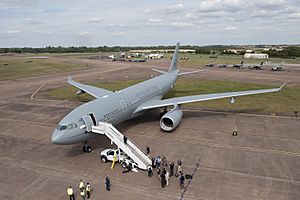No. 101 Squadron RAF facts for kids
Quick facts for kids No. 101 Squadron RAF |
|
|---|---|

Squadron badge
|
|
| Active |
|
| Country | |
| Branch | |
| Type | Flying squadron |
| Role | Air transport and air-to-air refuelling |
| Part of | No. 1 Group RAF |
| Home station | RAF Brize Norton |
| Motto(s) | Mens agitat molem (Latin for 'Mind over matter') |
| Aircraft | Airbus A330 Voyager K2/K3 |
| Battle honours |
|
| Commanders | |
| Current commander |
Wg Cdr Paul Summers |
| Insignia | |
| Squadron badge heraldry | Issuant from the battlements of a tower, a demi lion rampant guardant. The battlements symbolise the squadron's pioneering role in the development of power-operated gun turrets, while the lion indicates the unit's fighting power and spirit. Approved by King George VI in February 1938 |
| Squadron codes | LU (Apr 1939 - Sep 1939) SR (Sep 1939 - Apr 1951) MW ('C' Flight - May 1942) |
No. 101 Squadron is a special part of the Royal Air Force (RAF). This squadron flies the Airbus Voyager aircraft. Their main jobs are to refuel other planes in the air and to transport important cargo or people. They operate from RAF Brize Norton in Oxfordshire, UK.
Contents
History of the Squadron
How it Started: World War I
No. 101 Squadron was first created on July 12, 1917. This happened at Farnborough. They used a plane called the Royal Aircraft Factory FE2b. Just two weeks later, they moved to France. There, they flew missions as a night bomber squadron. The squadron returned to the UK in March 1919. It was then disbanded on December 31, 1919.
Reforming for World War II
The squadron was formed again in March 1928. This time, they were at RAF Bircham Newton. They started as a day bomber squadron, flying the Boulton Paul Sidestrand. In 1938, they got new planes, the Bristol Blenheim. By 1941, they switched to Vickers Wellington planes for medium-range bombing.
Special Missions in World War II
The next year, they received the famous Avro Lancaster bombers. In 1943, 101 Squadron's Lancasters got a secret system. It was called "Airborne Cigar" (ABC). This system could jam enemy radio signals. An eighth crew member operated it. This person often knew German. They would find and block German fighter controllers' messages. Sometimes, they even pretended to be German controllers to confuse the enemy.
Planes with the ABC system looked different. They had two large antennas sticking up from the middle. Using this jamming system meant breaking radio silence. This made the planes easier to find and attack. Because of this, 101 Squadron had the highest number of casualties of any RAF squadron during the war.
After the War: Jet Age Begins
In October 1945, the squadron moved to RAF Binbrook. In June 1946, they started using Avro Lincoln planes. These aircraft were used for small attacks in Aden in October 1947.
On May 25, 1950, the squadron received its first English Electric Canberra B2 jet bomber. This made them the RAF's first jet bomber unit! They even trained themselves to fly these new jets. By the end of 1950, they had nine Canberra B2s.
Missions in Malaya and Suez
In June 1954, 101 Squadron was the first to get the newer Canberra B.6. After training, they went to Malaya. They helped in Operation Firedog, a fight against communist groups. 101 Squadron became the first RAF jet bomber squadron to serve in the Far East. They arrived at Changi on February 11, 1955.
Their first jet bomb drop happened in Johore. Over two months, they flew 98 missions. They returned to Binbrook in June 1955. They went back to Malaya in 1956. Also in 1956, they flew night bombing missions against Egyptian airfields from Hal Far, Malta, during the Suez crisis. As newer "V bomber" jets arrived, the Canberras became less important for bombing. So, 101 Squadron was temporarily disbanded on February 1, 1957.
The Vulcan Era
The squadron reformed on October 15, 1957. They became part of the RAF's "V bomber" force. These planes carried nuclear weapons to protect the UK. They flew Avro Vulcan B1s from RAF Finningley. In 1961, the squadron moved to RAF Waddington. They stayed there until 1982. Their Vulcans were upgraded to the B1A model. These had special equipment to avoid enemy radar.
On June 20, 1961, a 101 Squadron Vulcan B1A flew non-stop from RAF Waddington to Australia. This was the longest non-stop flight ever by a Vulcan. It covered 10,000 nmi!
New Roles and the Falklands War
Later, enemy missiles made high-altitude bombing too risky. So, the Vulcans changed their tactics. They flew very low, then quickly climbed to drop their bombs. By December 1967, the squadron had eight Vulcan B2 aircraft. They carried special bombs that allowed them to stay low during release.
After the Royal Navy took over nuclear defense, the squadron got a new role. They would support ground forces in Europe. They would strike enemy targets with regular bombs and, if needed, tactical nuclear weapons. The squadron continued this role until the Falklands War in 1982. They flew missions during this conflict. Then, the squadron was disbanded again on August 4, 1982.
Modern Day: Air Refueling
In 1978, the RAF decided to turn old passenger planes into air refueling aircraft. These were Vickers VC10 planes. The first one flew in 1982. No. 101 Squadron was chosen to fly these new planes. They reformed at RAF Brize Norton on May 1, 1984.
The squadron has been involved in important missions. These include the Gulf War and the 2003 invasion of Iraq. The VC10 aircraft were retired on September 20, 2013. They were replaced by the Airbus Voyager, which the squadron flies today.
Aircraft Flown by 101 Squadron
Here is a list of the different aircraft types that No. 101 Squadron has operated throughout its history:
| From | To | Aircraft | Version |
|---|---|---|---|
| July 1917 | March 1918 | Royal Aircraft Factory B.E.12 | BE.12 |
| July 1917 | March 1918 | Royal Aircraft Factory B.E.12 | BE.12a |
| July 1917 | March 1919 | Royal Aircraft Factory F.E.2 | FE.2b and FE.2d |
| April 1928 | July 1936 | Boulton Paul Sidestrand | Mk.III |
| November 1928 | June 1929 | de Havilland DH.9A | |
| January 1935 | August 1938 | Boulton Paul Overstrand | Mk.I (four converted from Sidestrands) |
| June 1938 | April 1939 | Bristol Blenheim | Mk.I |
| April 1939 | May 1941 | Bristol Blenheim IV | Mk.IV |
| April 1941 | February 1942 | Vickers Wellington | Mk.Ic |
| February 1942 | October 1942 | Vickers Wellington | Mk.III |
| October 1942 | August 1946 | Avro Lancaster | Mk.I & Mk.III |
| August 1946 | June 1951 | Avro Lincoln | B.2 |
| June 1951 | August 1954 | English Electric Canberra | B.2 |
| June 1954 | January 1957 | English Electric Canberra | B.6 |
| October 1957 | May 1962 | Avro Vulcan | B.1 |
| March 1961 | December 1967 | Avro Vulcan | B.1a |
| December 1967 | August 1982 | Avro Vulcan | B.2 |
| May 1984 | February 2001 | Vickers VC10 | K2 |
| February 1985 | September 2013 | Vickers VC10 | K3 |
| April 1994 | September 2013 | Vickers VC10 | K4 and C1K |
| October 2013 | present | Airbus Voyager | KC2 and KC3 |
See also
- List of Royal Air Force aircraft squadrons





